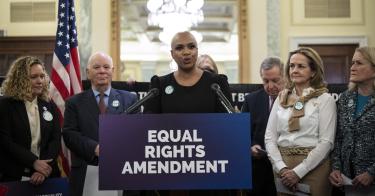“The Equal Rights Amendment has absolutely nothing to do with abortion,” insisted Representative Carolyn Maloney (D., N.Y.) in an April 2019 Judiciary Committee hearing. Maloney has been the ERA’s primary House sponsor for the past 25 years. Methinks, however, that the representative doth protest way too much. The ERA-abortion connection had already been established for more than 40 years when Maloney tried to deny it.
The 1972 ERA provided that “equality of rights under the law shall not be denied or abridged by the United States or any state on account of sex.” This was the only resolution, out of more than 1,000 introduced since 1923, to gain the two-thirds support that the Constitution requires to be sent to the states for ratification.
By 1972, however, the ERA’s costs far outweighed any potential benefit. Initially, backers said that without it legislatures would never eliminate sexually discriminatory laws and that courts would never interpret the Constitution to prohibit such laws. Both of those objectives, however, have been achieved without the ERA.
Legislatures began abandoning discriminatory laws in the 1920s. In ERA hearings during the 1930s and ’40s, even the National Woman’s Party, the ERA’s strongest promoter, conceded that the legislative trend “toward equality” was “unmistakable.” And while the 1972 ERA was pending before the states, the U.S. Commission on Civil Rights issued a report documenting legislative progress for women in a dozen different areas, including domestic relations, education, equal pay for equal work, retirement, and the criminal law.
>>> Not Your Grandmother’s ERA: Why Current Equal Rights Amendment Strategies Will Fail
The courts, too, began fulfilling the ERA’s purpose without it. Lower courts began applying the 14th Amendment’s “equal protection” principles to legislative classifications based on sex in the 1960s; the Supreme Court had moved its equal protection jurisprudence in the direction of sex equality even before Congress proposed the 1972 ERA.
The late Justice Ruth Bader Ginsburg said in a 1997 interview that there was “no practical difference between what has evolved and the ERA.” With the ERA’s goals being reached without it, ERA advocates had to find some other reason for it. This redirection occurred in five steps.
The first step, in the 1940s, saw ERA advocates associating it with international human-rights norms. Shortly after the United States approved the United Nations Charter, for example, witnesses in congressional hearings began arguing that such agreements actually required ratifying the ERA.
The next step was domestic. The 1977 National Women’s Conference’s “National Plan of Action” explicitly connected the ERA to the campaign for “reproductive freedom,” including eliminating limits on taxpayer funding of “all forms of family planning.” President Jimmy Carter’s newly appointed National Advisory Committee for Women dispelled any remaining doubt. At their first meeting in January 1979, the committee’s co-chairs asserted that the ERA was the “foundation on which all our proposals rest,” including resisting “the continued erosion of the Constitutional right to reproductive freedom.”
The third step came after the 1972 ERA’s ratification deadline passed with fewer than the necessary 38 states approving it. A Senate judiciary subcommittee held nearly a dozen hearings on the ERA’s possible impact, including one in January 1984 focused exclusively on abortion. Scholars on both sides of the abortion issue confirmed that the ERA could provide an alternative constitutional foundation for abortion rights.
Later that year, in the Joyner Lecture on Constitutional Law at the University of North Carolina School of Law, then-Judge Ginsburg argued that the Supreme Court’s decision in Roe v. Wade was “weakened” by its emphasis on “autonomy” rather than “a constitutionally based sex-equality perspective.”
The fourth step came when state courts began using ERA provisions in their state constitutions to strike down limitations on taxpayer funding of abortion. Witnesses in the 1984 Senate hearing had warned of this possibility for the federal ERA, and ERA advocates frequently said that the actual application of state ERAs was the best indicator of how the federal ERA would be applied if it was ever ratified.
>>> Equal Rights Amendment Cannot Be Ratified for One Rather Simple Reason
The final step is the increasing frequency of public statements by abortion advocates confirming that the ERA would support their cause. In the 1993 Madison Lecture at Harvard, Justice Ginsburg repeated her argument from a decade earlier that Roe “might have been less of a storm center” if it had focused on “the women’s equality dimension of the issue.”
Letters and statements by ERA supporters submitted for the same hearing in which Maloney denied any link between the ERA and abortion directly contradicted her. The American Civil Liberties Union, for example, sent a letter asserting that the ERA “could provide an addition [sic] layer of protection against restrictions on abortion, contraception, and other forms of reproductive healthcare.” After this hearing, Kelli Garcia, senior counsel at the National Women’s Law Center, said that the ERA “would help create a basis to challenge abortion restrictions.”
In its June 2022 decision in Dobbs v. Jackson Women’s Health Organization, the Supreme Court held that “the Constitution does not confer a right to abortion.” This will no doubt intensify the search by abortion advocates for a constitutional alternative. Despite denials that no one believes, the groundwork has already been laid, and all eyes are trained on the ERA.
This piece originally appeared in The National Review





